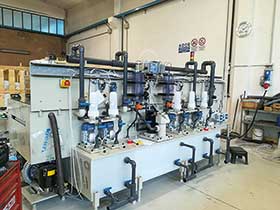

As technology advances annually, so do the laminates and materials used in the manufacture of printed circuit boards. These new laminates each bring different challenges during the manufacturing process due to their chemical composition and the specialised electrical properties they are designed to achieve. Many of these laminates require special processing and special equipment, especially the PTFE low-loss materials utilised in radar and RF applications. The modern challenges involved have led TraX Interconnect to add an MEC V-Bond process to its list of capabilities.
“Working with these new laminates and materials, particularly when it comes to soldermask application and innerlayer bonding, has meant investing in the new generation of chemical adhesion promoters,” explains TraX managing director, Daniel Dock. “In high-frequency printed circuit boards the surface roughness of the copper surface becomes an important factor affecting performance of the finished board. Current adhesion promoting treatments leave a surface that is too rough for high-frequency signals.”
Traditionally as part of the manufacturing process of a printed circuit board, a polymer ink (soldermask), most often green in colour, is applied to the circuit board to cover the copper traces of the circuit that do not require soldering. The purpose of the soldermask is to provide an electrically non-conductive, protective layer over the copper traces that make up the electronic circuit. Failure to protect these traces will result in oxidation of the copper and cause damage to the circuit.
If the surface of the copper traces being covered by soldermask is not suitably prepared then the soldermask will peel off and not stick to the copper surface. This can be equated to traditional surface preparation of most surfaces prior to painting.
“In printed circuit board manufacturing, much like painting preparation, we used to rely on abrading of the surface to be covered by soldermask,” Dock continues. “This was done by passing the printed circuit boards through conveyorised equipment containing round abrasive rollers that press down on the board surface as they pass between them. This can be compared to sanding before painting, with the resultant fine scratches in the copper surface making it possible for the soldermask to stick.
“The problem with this process is that the scratches on the copper traces are a problem in boards manufactured to operate at high frequencies, since these scratches affect the signals running at high speed across them. By implementing this new surface treatment at TraX we will be able to ensure that we provide sufficient adhesion for solder mask whilst leaving the copper surface as smooth as possible.”
Dock concludes by saying he is confident this new process puts TraX in a better position to manufacture boards for radar, aerospace and military applications where controlled impedance and high frequencies are critical factors.
For more information contact TraX Interconnect, +27 21 712 5011, [email protected], www.trax.co.za
| Tel: | +27 21 712 5011 |
| Email: | [email protected] |
| www: | www.trax.co.za |
| Articles: | More information and articles about ICAPE TRAX / ICAPE South Africa |

© Technews Publishing (Pty) Ltd | All Rights Reserved